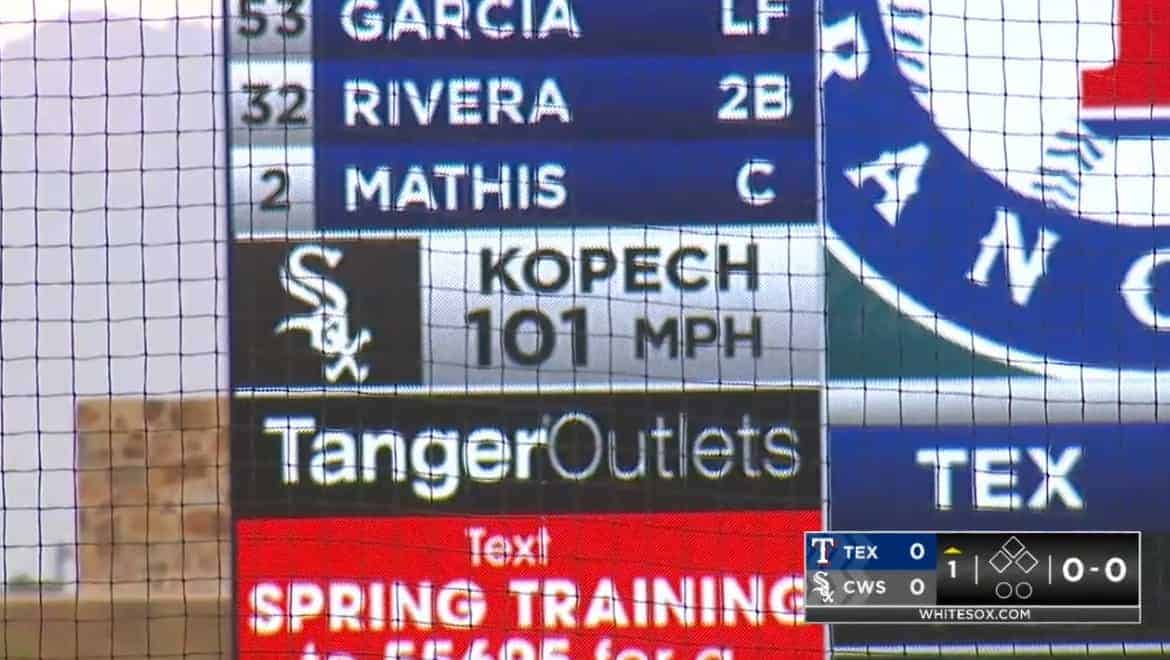From the threat of rain to the ecstatic radar gun readings, Kopech Day is back.
The skies held up long enough for Michael Kopech to make his spring debut in Tuesday's Cactus League action against the Rangers, and nobody left disappointed ... unless they showed up more than three minutes and 38 seconds after first pitch. Kopech wrapped it up in 3:37. They would've missed everything.
Kopech needed just 11 pitches for a 1-2-3 inning, getting a couple groundouts up the middle to a shifted Leury García, then locking up Greg Bird with an outside corner fastball.
More than results, the velocities were what everybody wanted to see going into the start, and fortunately, the velocities were what everybody wanted to show on Twitter after it happened.
I logged each pitch, and Scott Merkin logged each velocity reading from the scoreboard. Combined:
- High fastball, 100
- Low fastball, 101
- Low fastball strike, 100
- Grounder to second, 101---
- Crisp curve strike, 82
- Fastball down the middle, 4-3, 101---
- Fastball up and away, 98
- Curve strike, 81
- Slider, just missed, 90
- Slider fouled off, 90.
- Fastball outside corner, 101
The White Sox provided a sampling of visuals:
Kopech said after the game that he doesn't expect to sit triple digits during the regular season, saying he "might have been a little geeked." It might not quite be the new normal, but there's value in him showing it early and often.
The White Sox didn't have a whole lot of success to point to when bringing guys all the way back from Tommy John surgery. Zack Burdi is framing his velocity restoration as a years-long process -- he's still about 3-4 mph short -- and Micker Adolfo couldn't really start throwing in earnest before doctors had to open his elbow again.
Seeing Kopech show up and look no worse for the wear was a sight for sore arms. His triple-digit smoke didn't come as a complete surprise since he lit up a radar gun or two in the instructional league, but throwing down in a widely accessible manner adds heft to the milestone, trust-but-verify and whatnot.
(It also doesn't hurt that the breaking pitches he mixed in looked like the way he wanted to throw them.)
Dylan Cease's last two outings serve as a reminder that a promising young pitcher can relapse after a spring showcase, but most aren't expecting Kopech to string together a tidy sequence of starts and be ready for Chicago by April. There will probably be bumps as he builds up, days that his command isn't sharp or his breaking balls spin on him.
Velocity tends to be pretty stable, though, so seeing him come out firing one hundo after another is a terrific introduction. And when you realize how little the projection systems are expecting from him, a lot of the team's potential overachievement is contained in his right arm.
* * * * * * * * *
Speaking of projections, Greg dropped the links to The Ringer's White Sox Day coverage in Tuesday's discussion. If you missed them, it's a three-part series:
The middle link includes a graph that shows why the White Sox needed to rebuild, and why I wasn't crazy about this front office getting a second chance to make it work. At 84ish wins, this is the most projectable White Sox team in the last 15 years.
:format(webp):no_upscale()/cdn.vox-cdn.com/uploads/chorus_asset/file/19781154/White_Sox_Projected_Wins.png)
Even during their more successful seasons over this stretch, the White Sox never projected well. They prided themselves on beating the math, but it didn't make postseason appearances any easier to come by. Eventually their savvy ran out and their extreme loyalty caved them in, and even Don Cooper seems to recognize what little value is left in the "old school" façade.
An 84-win forecast shouldn't feel like such a triumph, but between the beatable projections for Kopech and Cease, and Luis Robert's extreme ceiling, one can see the White Sox lifting this number from within. All these guys should be allowed to struggle and find their way in their first full pro seasons, but there's a huge payoff in store if they can accelerate the process.





